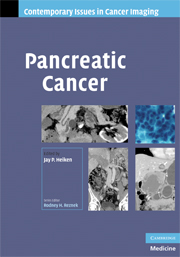Book contents
- Frontmatter
- Contents
- Series Foreword
- Preface to Pancreatic Cancer
- Contributors
- 1 Epidemiology and genetics of pancreatic cancer
- 2 Pathology of pancreatic neoplasms
- 3 Multi-detector row computed tomography (MDCT) techniques for imaging pancreatic neoplasms
- 4 Magnetic resonance imaging (MRI) techniques for evaluating pancreatic neoplasms
- 5 Imaging evaluation of pancreatic ductal adenocarcinoma
- 6 Imaging evaluation of cystic pancreatic neoplasms
- 7 Imaging evaluation of pancreatic neuroendocrine neoplasms
- 8 Role of endoscopic ultrasound in diagnosis and staging of pancreatic neoplasms
- 9 Surgical staging and management of pancreatic adenocarcinoma
- 10 Treatment of locally advanced and metastatic pancreatic cancer
- 11 Rare pancreatic neoplasms and mimics of pancreatic cancer
- Index
- Plate section
- References
7 - Imaging evaluation of pancreatic neuroendocrine neoplasms
Published online by Cambridge University Press: 23 December 2009
- Frontmatter
- Contents
- Series Foreword
- Preface to Pancreatic Cancer
- Contributors
- 1 Epidemiology and genetics of pancreatic cancer
- 2 Pathology of pancreatic neoplasms
- 3 Multi-detector row computed tomography (MDCT) techniques for imaging pancreatic neoplasms
- 4 Magnetic resonance imaging (MRI) techniques for evaluating pancreatic neoplasms
- 5 Imaging evaluation of pancreatic ductal adenocarcinoma
- 6 Imaging evaluation of cystic pancreatic neoplasms
- 7 Imaging evaluation of pancreatic neuroendocrine neoplasms
- 8 Role of endoscopic ultrasound in diagnosis and staging of pancreatic neoplasms
- 9 Surgical staging and management of pancreatic adenocarcinoma
- 10 Treatment of locally advanced and metastatic pancreatic cancer
- 11 Rare pancreatic neoplasms and mimics of pancreatic cancer
- Index
- Plate section
- References
Summary
Introduction
Neuroendocrine neoplasms (NEN) or islet cell tumors of the pancreas are rare neoplasms that produce and secrete variable amounts of hormones. These neoplasms can be intraparenchymal or exophytic and can be associated with genetic syndromes such as multiple endocrine neoplasia type I (MEN I), von Hippel–Lindau disease, neurofibromatosis type 1 and tuberous sclerosis [1]. Neuroendocrine neoplasms can be divided into hyperfunctioning or syndromic neuroendocrine tumors (H-NENs) that generate sufficient hormonal activity to create a clinically recognizable endocrine syndrome, and non-hyperfunctioning or non-syndromic neuroendocrine tumors (N-NENs) that are clinically silent because they produce insufficent levels of hormones. The H-NENs produce distinctive signs and symptoms that lead to an early clinical diagnosis. Insulinomas tend to be small whereas all other H-NENs (gastrinoma, glucagonoma, VIPoma, somatostinoma, corticotropinoma, GRFoma, parathyrinoma and carcinoid) usually are large [2]. The N-NENs present late, produce symptoms related to mass effect and may be large. Larger NENs exhibit more aggressive behavior, including local and vascular invasion and distant metastases.
Imaging tests for detecting and characterizing NENs include multi-detector row CT, magnetic resonance imaging (MRI) with gadolinium enhancement, endoscopic ultrasound (EUS), somatostatin receptor scintigraphy (SRS) and positron emission tomography (PET) [3–10]. Under special circumstances, angiography also is used [11]. This chapter will review clinical signs, imaging features, diagnostic evaluation and treatment of pancreatic NENs.
Clinical features of H-NENs
Tumors producing islet- and gut-related hormones
Insulinoma
Insulinoma is the most common NEN and presents with the Whipple triad consisting of hypoglycemia, low fasting glucose levels (< 50 mg/dl) and relief of symptoms with glucose administration (Table 7.1).
- Type
- Chapter
- Information
- Pancreatic Cancer , pp. 104 - 129Publisher: Cambridge University PressPrint publication year: 2008



